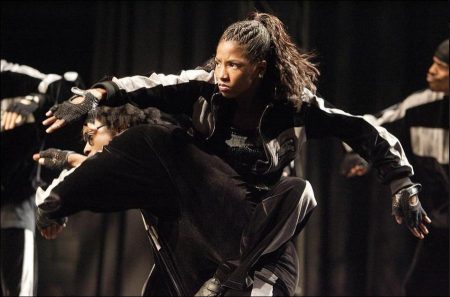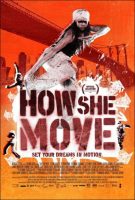Tagline: Set your dreams in motion.
Raya Green is seventeen-years-old, incredibly bright and full of promise. She attends a prestigious private school outside her tough, crime-ridden neighborhood. When a family tragedy leaves her family unable to pay her tuition, Raya is forced to return to the old community she so desperately wants to escape.
She soon finds herself drawn into the world of underground dance competitions and smells an opportunity to win some money, get out of the neighborhood, help her family and return to her old school. But as the dance tournament unfolds, Raya realizes that real success only comes to those brave enough to tackle it on their own terms.
How She Move is a 2007 drama film directed by Ian Iqbal Rashid and starring Rutina Wesley, Clé Bennett and Romina D’Ugo. The film showcases the street culture of step dancing. The film is produced by Celluloid Dreams, Sienna Films, Paramount Vantage and MTV Films.
This Canadian film was original slated to open in Canada in March 2007, but when it picked up a distribution deal from Paramount and MTV at the 2007 Sundance Film Festival, the release date was pushed back to allow for reshooting several of the dance sequences, particularly the finale.
The film was shot on Super 16mm for $5 million, and Paramount invested another $2 million in the new sequences, re-editing, and new sound mix. They created a new soundtrack with American and Canadian hip-hop artists. The film was originally set and filmed in Toronto, but the new edit removes references of the team travelling from Toronto to Detroit for the dance competition. Paramount / MTV spent another $10 million in promotion and distribution to 1500 theatres in the United States and 50 in Canada.
About the Production
Stepping, an intensely rhythmic, percussive and expressive form of dancing that began as a way of connecting people in Africa, has suddenly become a major phenomenon across North America. It was first seen in the U.S. in the 1920s when college students called it “marching,” but it wasn’t until Spike Lee’s SCHOOL DAZE that stepping first hit the big screen.
Since then, stepping has become hotter and hotter – not just among university students and not just in hit Hollywood films such as DRUMLINE and STOMP THE YARD, but on the streets as well, in inner cities where stepping is increasingly becoming both a thrilling form of competitive art and a way for a talented few to literally “step up” into a more promising future.
For director Ian Iqbal Rashid, fresh off the sensational reviews of his debut indie film TOUCH OF PINK, stepping was a way to tell a raw, honest, urban coming-of-age story with plenty of grit but also lots of dynamic style. Having fallen in love with such iconic and inspirational dance films as FAME, FLASHDANCE and SATURDAY NIGHT FEVER as a kid, he’d long dreamed of one day making that same kind of heartfelt, music-driven, culturally authentic story that merged movement, music and the rhythms of the human heart – but for a different generation.
So when he came across Annmarie Morais’ dance-fueled but character-focused screenplay, HOW SHE MOVE, about a fiercely driven, young Jamaican immigrant who discovers that stepping in an all-male crew might be her ticket out of a dead-end neighborhood, Rashid himself was powerfully moved. He was impressed by how the story of HOW SHE MOVE interwove elements of a young woman taking a risk to become who she really is with themes of friendship, family and class – and, most of all, heart-pounding, hypnotic dance sequences that intensified the tale’s volatile mix of emotions with sheer motion.
“I saw HOW SHE MOVE so clearly as I was reading it,” recalls Rashid who, like the film’s lead character, grew up in urban Toronto as an immigrant, his family having sought asylum there from his native Tanzania. “I love dance and music, and dance tells so much of this story – so much texture and emotion are played out through it. Yet, the film also speaks to the scars of migration, a theme that very much interests me and runs through all of my work. I was also drawn to it because it’s a story that talks about different ways of winning; and how winning doesn’t always look how you think it’s going to look.”
The story of Raya Green’s complicated, yet rousing quest to step her way out of despair and into her own identity began with the passion of rising young screenwriter Annemarie Morais. Morais, herself a Jamaican immigrant who grew up in Canada, developed a deep love of stepping while studying at Canada’s York University. She was exhilarated by step’s inherent pendulum of feelings – how it could be at once celebratory and fierce, sexy and strong, angry and bursting with life. Although she claims to be rhythmically challenged, having never stepped competitively herself, Morais became a passionate fan of step competitions. “Step is so much about personal expression,” she says. “There’s so much energy and such a strong sense of community feeling in it. The same way that hip-hop became the voice of a generation, I think step is bringing out a certain expression of our past and our present through dance in a powerful way.”
While still at York, Morais would go on to make an award-winning short documentary, STEPPIN TO IT, which followed the pressures and preparations surrounding co-ed step teams getting ready for a big contest. But even after that, the subject continued to compel her and Morais began to link it up with her desire to write a screenplay that would have a young black woman as its central heroine. Thus was born Raya Green, the fiery, fiercely intelligent young woman who thought her plan to escape a rough-hewn immigrant community was all in place – until her sister’s death from a drug overdose changed everything and brought her back home to start all over again.
Morais wrote from the heart and from the intimate emotions of her own personal experience, but she also felt instinctively that the themes of the film would be universal. “I think everybody knows what it’s like not to know what to do with your life,” she explains “Everybody knows what it’s like to have family pressures that you just don’t know how to get out of, and relationship pressures, and all these expectations and huge life decisions that you have to make when you’re that age. It’s an overwhelming time and whether you’re from New York or Toronto, that situation applies.”
Certainly, the dance in the film speaks a language that crosses all borders. Even while working on the page, Morais felt the stepping sequences come alive in her mind’s eye. “The story’s really about one girls’ journey to figure out her life, and step gives her a power and a voice to find her way in the world,” she explains. “I tried to put all of Raya’s pain and anger and frustration into motion and, as I was writing, I always saw her movements in my head. The heart of the story is the relationships and how that influences who Raya is – but the dance became an expression of those things.”
Morais set her story in a unique locale few filmgoers have seen: Toronto’s “Jane-Finch corridor,” an area of low-income and public housing that became a melting pot of multi-ethnic culture in the middle of the city, teeming with new, often impoverished, immigrants from across the globe. Today, the Jane-Finch Corridor is home to 75,000 people from 80 ethnic groups, speaking 112 different languages. A high-density area rife with drug and gang-related crime, it is also a vibrant, restless area home to many unseen dreams and dramas.
For Morais, it was important that Raya see that leaving Jane-Finch behind – turning away from her own personal history — is not the key to starting her life anew. “The idea that you have ‘to leave to achieve’ is no longer true, and I think people need to be reminded that you can affect change wherever you are and whatever your situation is. Your success is not about your location,” says Morais. “It’s about your determination. Whatever it is that you desire, it’s not a matter of you have to be from here or you can’t be from Jane-Finch. It’s your own determination that charts your future.”
Having conceived this dance-driven story of self-determination that unfolds in a strong female voice, Morais was thrilled when two women came on board to develop and produce HOW SHE MOVE. She first brought the idea to Jennifer Kawaja and Julia Sereny of Canada’s Sienna Films because she was enjoying working with them on other projects and thought they might be interested in the subject matter.
Kawaja and Sereny, who have a reputation for seeking out edgy, risk-taking material, not only were intrigued by the subject matter, they were impressed with Morais’ distinctive approach to it. “Jennifer and I are both great fans of dance films,” says Sereny. “In HOW SHE MOVE, the dance is integrated into the roots of the story and the emotions — whether it be passion, humor, tragedy, defiance, or stubbornness – are clearly reflected through those sequences. The dance is an extension of each of the characters, not separate from them.”
Adds Kawaja: “We thought a lot about the themes and ideas that are in the film – especially the idea that if you come from a disenfranchised community, the most brutal thing that can happen to you is that your hope is killed, your ability to dream is killed. The story is a very delicate balancing act between these themes and the life-affirming joy of dance.”
It was Kawaja and Sereny who brought the project to director Ian Iqbal Rashid. They had recently produced his first film, the award-winning comedy TOUCH OF PINK, which starred Kyle MacLachlan, and thought he would have an affinity for the material.
As they’d hoped, Rashid responded immediately and intensely. “I really liked the central character, Raya, and related to her in so many ways,” he says. “And then I started doing more research into the whole stepping culture, and that really moved me, too. Its history is so rich and poignant and rooted in African-American aspiration, and I thought it would be a real privilege to work on a project that would bring step further into popular culture.”
It was the film’s mix of unusually stark realism surrounding the explosive dance sequences that made it really work for Rashid. “This is a story about kids who are yearning for a better life, which is a classic theme in a lot of musical and dance films,” he notes. “Raya, our central hero, becomes an ever fiercer competitor and ever fiercer dancer as her journey continues, but then she also begins to get in touch with the person she really wants to be. So it truly becomes a coming-of-age story that is realized through dance numbers.”
About The Moves
With the cast set, Ian Iqbal Rashid now faced the considerable challenge of bringing to life his vision of merging the intensity of a gritty coming-of-age drama with the pulsating rhythms of street-style dance. Almost like a 21st century musical, the story’s emotional climaxes are expressed explosively through the film’s show-stopping dance numbers. Step lends itself to inner expression -since steppers use their bodies as instruments, making the very rhythm to which they are dancing with their hands and feet, feelings that range from fury to ecstasy come to fore in visually exciting ways. But it takes tremendous finesse and creativity to bring out the maximum visceral quality from the moves.
Inspired by the looser manner of Toronto’s street steppers, who mix-master step with hip-hop and break-dance to create hugely kinetic, acrobatic, breathtaking routines, Rashid knew he would need a choreographer who really understood contemporary street dance from the inside out – and could actually translate the emotions of the story through original moves. The filmmakers found that rare combo in Hi-Hat, hip-hop’s so-called diva of dance, who is renowned for working with such artists as Missy Elliot, Eve and Kanye West. As one of the few women working in this male-dominated arena, Hi-Hat brought something else essential to the film: a natural affinity for choreographing for women in strong, beautiful and unexpected ways.
“Hi-Hat has worked with Missy Elliot on some of her best videos, as well as with P-Diddy, Wyclef Jean and Mary J. Blige. In a lot of music videos, women’s bodies are used as props, most often with sexual overtones, but Hi-Hat works with female dancers in much more complex and interesting ways,” says Jennifer Kawaja. “Even her sexiest routines don’t objectify women’s bodies – instead she gives the female dancers power and dignity. And she had what was most important to us: the skills to relate the dance to each one of the story’s characters.”
When first approached, Hi-Hat admits she was skeptical, but once she read Annmarie Morais’s script, she couldn’t resist the challenge. “I could really relate to Raya’s struggle to be recognized,” she explains, “and it’s so rare to see a female lead in a black dance film. The character of Raya inspired me because she can hang with the guys when it comes to dance and she’s fearless and she reminded me of my own passion for dancing. I also loved that the film looks at a real Caribbean immigrant community – the language and the emotions are all very true to life, and you don’t see that too often.”
Right away, Hi-Hat envisioned bringing a high-energy polyglot of dance styles to the story. “I wanted to not only bring in step but amazing hip-hop, amazing breakdancing, and an amazing Jamaican reggae feel,” she says. “I wanted to have interesting movement, unique movements, as well as lots of fun movement.”
That wide-open approach was perfectly in synch with Rashid’s. “I wanted something bigger, bolder and rawer and I liked that Hi-Hat was mixing crumping moves and other hip-hop styles with step. The mix of different dance forms adds to the originality and the appeal of the dance numbers,” says the director. “Hi-Hat was able to come up with choreography that was perfectly matched with the strength and spirit of the characters.”
Hi-Hat irreverently worked outside the lines but started with a deep appreciation for the history and legacy of stepping. Step is most often traced to a folkloric South African form known as gumboot dancing, which spread among laborers and miners, often allowing a mix of ethnic groups who spoke different languages to communicate via rhythm and sound. They used the only instruments available to them: their boots and their bodies. By stamping, clapping, and even rattling ankle chains, they developed dances that expressed to one another all the heartache and yearning of working-class life and that became a popular form of social activity.
This “gumbooting” combo of footsteps, claps and spoken word storytelling made its way into African American sororities around the turn of the 20th Century. It remained largely a college phenomenon until recently, when step began to spread out into new areas, cultures and dancers, who have kept it dynamically changing by adding in elements as diverse as martial arts, cheerleading, hip hop, tap dancing, ethnic dance and acrobatics. But no matter what goes into it, what comes out is a way of dancing that is a lot like storytelling. “The culture of stepping is all about communication and creating a group bond,” explains Hi-Hat.
The vast creativity of step allowed Hi Hit to develop distinctive dance styles that would reflect each of the very different personalities of HOW SHE MOVE’s characters. She elaborates: “Raya is always very creative with her emotions, so if she is angry or if she’s happy, she creates that with her moves. Whenever Bishop and his crew perform, it is uplifting for the crowd, and you want to join in. Garvey is slick, so I wanted his team to be acrobatic. That’s where the break dancing comes in: it’s energetic and it’s intense. Michelle’s crew is another style, another flavor. She’s sexy. So it’s rugged and it’s raw and diva-ish.”
Hi-Hat found herself constantly inspired to come up with new moves for the characters. But the question was: could the cast, many of whom had never stepped before, keep up? The key would be to intensively training them to step with the passion and skill of real competitors with everything on the line.
Step Camp
To help train the cast to perform Hi-Hat’s wildly creative choreography, the young stars were inducted into a literal “boot” camp in which they donned their Timberland boots for eight hours of rehearsal a day over a period of five extremely intense weeks. Hi-Hat knew she was asking for the impossible, but somehow she got it. “Stepping is all about rhythm, so it’s hard not only for actors, but for dancers,” says Hi-Hat. “The thing is that the cast really wanted to do this, they were determined, they worked hard and they truly became their characters because of it. Everyone was focused on making this a great dance movie – and that’s what did it.”
The cast was amazed by their own transformations. Rutina Wesley admits she was intimidated at the start of rehearsals but soon found she was dancing with all the abandon and fervor of Raya. “I had never done step before, but Hi-Hat made me want to dance. She is such a mommy. Step began to make my pulse race; I connected with the ground under my feet.” Tré Armstrong was equally awed by all the hard work and its pay off. “Eight hours a day, five days a week, for five weeks we worked it. It was grueling, but look at me now — I’ve never looked this good!” she muses.
Shawn Desman, who plays Trey, was in a state of shock at how difficult and physically taxing the training could be, even for a pro dancer. “I’m all about dancing, but the first week of rehearsals, my body was killing me. I’ve been dancing since I was 12 years old, and my body had never felt like that, all that clapping and stomping – even my hands were bruised and I could barely walk. But after a couple of weeks I was fine.”
Dwain Murphy adds: “If I hadn’t had the full five weeks of rehearsal, I would have been nowhere. It’s actually not easy to make it look easy! It also was not just about dancing, it was about learning how to dance in character, which is a challenging thing for an actor.”
In the end, the filmmakers were duly impressed with the way the cast stepped it up and made both the choreography and the drama come alive in equal measure. The mix of actors and dancers seemed, in the end, to heighten both elements. Says Ian Iqbal Rashid: “Tré, who plays Michelle, had never acted before but is a professional dancer. Rutina Wesley, who plays Raya, has never danced professionally, but has a strong acting background. So everybody had a different level of experience and the best part was that we all shared our strengths and found a way to make it mesh together.”
Moving To The Music
With such explosive and emotional dance routines, next the filmmakers began looking for music that might sonically echo the incredible verve and vibrancy of the dancers as well as their neighborhood. Rather than going for familiar hits, they wanted to remain true to the film’s roots and use lots of authentic music from Canada’s cities. Explains producer Jennifer Kawaja, “HOW SHE MOVE does have huge tracks in it, from ‘Bad Man’ from Missy Elliott, ‘Touch It’ from Busta Rhymes and ‘Is It Good (To You)’ from Yummy Bingham. But is was more important to us that a lot of the music come from the community we’re portraying, and that we showcase Canadian artists whose music is a reflection of their background, just as dance is for the characters in the film.
HOW SHE MOVE features music from a wide-ranging slate of Canadian artists, from heavyweights such as Saukrates (who wrote an original track, “Monster,” for the film), to newer voices such as Mood Ruff (“Don’t Let It Slip Away”) and Tasha T (“Rectify”). Artists representing Toronto include Mayhem Morearty (“Out Here”), who grew up in the city’s Lawrence Heights (aka “Jungle”) metro-housing complex, and Smugglaz (“Jane & Finchin'”), whose members hail from the same neighborhood as Bishop, Raya, Michelle and their friends and who have become leaders of the thriving Jane-Finch hip-hop scene.
Another rising Toronto star, Cali (aka Sarah Francis), who was seen this year in HAIRSPRAY, appears in HOW SHE MOVE as a member of the FemPhatal dance crew, and her track “Bout ‘It” is featured on the soundtrack. HOW SHE MOVE also features music by Winnipeg’s hip-hop/reggae artist Fenom (“Reflections”) and Montreal’s Carl Henry (“Perfect”). From across the border, Philadelphia’s new sensation, Kevin Michael, along with beatboxer Akil Dasan, contributes a track (“It Don’t Make Any Difference To Me”), and Brooklyn’s Lil Mama contributes two (“Life” and “G Slide”).
HOW SHE MOVE also required very specific kinds of tracks for Hi-Hat’s high-energy routines. For that job, Hi-Hat brought in long time collaborator Montell Jordan of Atlanta’s J&J Productions. J&J has written and produced for such artists as Whitney Houston, Gladys Knight, Deborah Cox, Dru Hill, Sisqo, Heavy D, and the list goes on. Their unique Atlanta beats and their knowledge of stepping provided the perfect accompaniment to Hi-Hat’s blend of step, hip hop and breaking. Finally, rounding out the musical tapestry of HOW SHE MOVE is the original score by Canadian composer Andrew Lockington.
The Look Of How She Move
Ian Iqbal Rashid shot HOW SHE MOVE just outside of Toronto in a neighborhood similar to the one in which both he and the film’s lead character grew up. “We shot in a neighborhood so much like mine, I felt like I was starting from the inside out,” says Rashid.
When it came to the look of the film, Rashid wanted to match the nature of stepping – keeping the visuals hard, powerful and edgy. He worked closely with cinematographer André Pienaar and production designer Aidan Leroux to keep the emphasis of the design on the very raw and gritty nature of Raya’s surroundings. To this end, much of the film was shot with a 16-mm handheld camera.
“The film is about movement – about movement through dance as well as upward mobility and ambition,” says Rashid. “I wanted to further excite that theme of motion through the way we shot the film. We worked a lot with a Super-16 camera, which is relatively light and mobile, and tried to keep the camerawork constantly alive. Also, during the editing process, we tried to leave each scene with a feeling of movement, even if it’s expressed as subtly as through an unfinished gesture. I wanted to provide a sense that, even when unobserved, the characters continued to move, to yearn.”
Rashid was especially influenced by the style of German photographer Thomas Struth, whose vast, almost clinical cityscapes dissect the rhythms of modern life; and the raw, moody quality and deep hues used in the palette of American photographer Nan Goldin, whose emotionally intimate shots have won international recognition.
“Our aesthetic was chosen with a view to giving the film a more immediate feel,” Rashid explains. “In the end, it’s a chunky, modernist vision — clean lines, girth, hard edges, muted colors and very spare – not the vivid tenement urban jungle we’re used to seeing in American films. The buildings that surround the characters are modern and spread far apart and lonely. It’s a cold landscape, but the people who live there find a way to warm it.”
How She Move (2008)
Directed by: Ian Iqbal Rashid
Starring: Tracey Armstrong, Rutina Wesley, Clé Bennett, Nina Dobrey, Romina D’Ugo, Kevin Duhaney, Shawn Fernandez, Brennan Gademans, Jai Jai Jones
Screenplay by: Annmarie Morais
Production Design by: Aidan Leroux
Cinematography by: André Pienaar
Film Editing by: Susan Maggi
Costume Design by: Kimberley Ann Rush
Set Decoration by: Liesl Deslauriers
Art Direction by: Rhonda Moscoe
Music by: Andrew Lockington
MPAA Rating: PG-13 for some drug content, suggestive material and language.
Distributed by: Paramount Vantage
Release Date: January 25, 2008
Visits: 64





